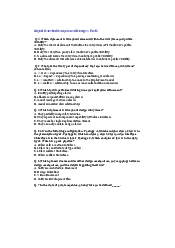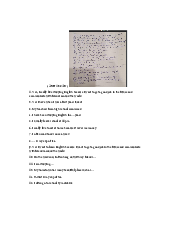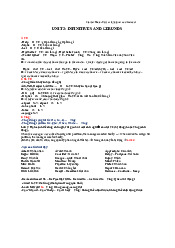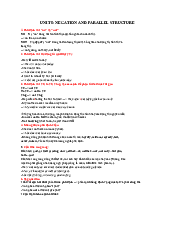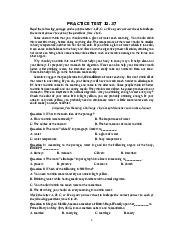







Preview text:
Reading: Self-awareness
“Knowing yourself is the beginning of all wisdom.” – Aristotle
Exploring our true selves is the key to personal development. The journey
of self-discovery begins by asking ourselves a fundamental question: "Who
am I?" By engaging in this inward journey, we increase our self-awareness
and gain a deeper understanding of our inner selves. This increased self-
awareness allows us to make conscious decisions that align with our
authentic selves, leading to a more purposeful and fulfilling
life. Moreover, this enhanced self-awareness facilitates more effective
communication with others. By being conscious of our own behaviors in
group settings or during interactions with individuals, we become more
aware of how our actions impact others.
Let’s delve into the concept of self-awareness and explore strategies to enhance it.
1. What is self-awareness?
According to Kreibich et al. (2022), self-awareness refers to our awareness
of our own patterns of thinking, feelings, and behaviors. Although we all
have some understanding of our own selves, some of us are more self- aware than others.
elf-awareness can take several forms. According to Eurich (2018), there
are two types of self-awareness - internal and external. Internal self-
awareness, or self-consciousness, refers to how clearly we see our inner
thinking, feelings, behaviors, strengths, weaknesses, values, passions,
aspirations, etc. External self-awareness involves understanding how
others see us. In addition to these types, comes
situationalself-awareness
into play in specific situations or contexts. This type of self-awareness
allows individuals to be aware of their experiences in the moment and
adjust their actions accordingly (Govern & Marsch, 2001). For example:
Minh knows that he has a tendency to avoid speaking up in large groups
because he feels shy in crowds (internal self-awareness). His friend Lan
told him that he came across as aloof and uninterested during the
group meeting because he did not participate much in the group
discussions. Minh realized from Amanda's feedback that his quietness
could be perceived as disinterest by others (external self-awareness).
During yesterday's team meeting, Minh noticed that he had not contributed
any ideas to the discussion. He was aware at the moment that his shyness
was preventing him from engaging with the group. He made an effort to
speak up more as the meeting progressed (situational self-awareness).
2. Why don’t we see ourselves clearly?
Vazire and Carlson (2010) have identified two barriers to our self-
awareness: informational barriers and motivational barriers.
Informationalbarriers refer to the limitations in objective feedback or
reliable data on their thinking, feelings, and behaviors. We often rely on
internal perceptions, which can be influenced by biases, stereotypes, and
cognitive distortions. Therefore, we may overestimate or underestimate certain aspects of ourselves.
Motivationalbarriers refer to the psychological factors that affect our
willingness to acknowledge and explore parts of ourselves that make us
uncomfortable or feel threatened. Our desire to enhance our self-image can
cause us to focus on our positive qualities and ignore our flaws. It's natural
to seek self-esteem and protect our self-image, which may result in
defensive mechanisms that prevent us from addressing negative aspects of
ourselves. The fear of being judged or vulnerable can also discourage us
from engaging in self-reflection. As a consequence, we may avoid
feedback or situations that challenge our self-concept, which can impede
our potential for self-awareness and growth.
3. How to overcome barriers to self-awareness or how to enhance self-awareness?
Mindfulness practices have been found to enhance self- awareness (Carlson, 2013).
Mindfulness = attention to one’s current experience + non-judgemental observation of the experience
Why mindfulness practices?
- increase the amount of information we have about our patterns of
thinking, feeling, and behaving (address informational barriers)
- reduce reactivity and defensiveness to ego-threatening information
(address motivational barriers)
During this course, we will engage in mindfulness exercises and build our
self-map to enhance our self-awareness. Reading: Personal values
Have you ever wondered why some people prioritize relationships and
family over their career aspirations while others focus on achieving
professional success? Or what motivates people to engage in community
service and volunteer work? Or what factors influence people’s lifestyle
choices, such as their dietary preferences and consumer behavior? The
answer to these questions lies in the values we uphold. These values play
a crucial role in shaping the decisions we make.
What does “Personal Values” mean?
Personal values are the fundamental beliefs that guide our lives and
influence our choices over time and in different situations. They act as a
moral compass, helping us make decisions that align with our true selves
and contribute to our sense of purpose and fulfillment. Our values impact
our actions and preferences and serve as important guiding principles in life (Sagiv et al., 2017). For example:
Minh’s core value is "family first." He consistently prioritizes spending time
with his parents over socializing with friends. Minh has chosen a job near
his parents’ home despite the lower salary it offers compared to another
position in another city. For him, being able to care for his parents, share
meals, and spend time with them is more valuable than financial gain.
Mai’s core value is “adventurous.” During her free time, Mai likes to go
trekking in Sapa or go on motorbike tours throughout the country. In her
professional life, Mai looks for work opportunities that provide challenges.
She thrives in environments that promote creativity, risk-taking, and ongoing education.
Where do values come from?
According to Sagiv et al. (2017), values can be acquired through learning.
Initially, people develop values through interactions with role models like
parents and teachers. These values become a part of our personal value
system over time. As a result, individuals from the same cultures often
share certain hierarchies of values due to these shared influences.
Apart from social and cultural factors, our personality also plays a
significant role in shaping our personal value priorities. Depending on our
character and temperament, we may find ourselves making choices when
faced with conflicting values, leading to the further refinement of our
values (Parks & Guay, 2009).
Values often change the most during adolescence and young adulthood,
particularly for college students. Once people reach adulthood, their values
tend to remain stable. However, as values come from social interactions,
exposure to new environments can lead to changes in our values structure.
Why is it important to be aware of our personal values?
- Our values can impact motivation. When we set goals that align with our
values, we become more committed to achieving them, resulting in higher
performance and increased satisfaction (Schwartz, 1992).
- Values impact our emotions. Acting in accordance with our values brings
about positive emotions like fulfillment, contentment, and happiness while
conflicting with them can lead to negative emotions such as guilt or
frustration. Therefore, recognizing and living in harmony with our values
can greatly enhance our psychological well-being (Parks & Guay, 2009).
- Being aware of our personal values helps us make informed and
meaningful decisions (Parks & Guay, 2009).
- Understanding our values can help us create significant connections with
others. When our values match with those of people around us, it creates a
feeling of shared purpose and connection. For example:
- Mai’s love for adventures may make it challenging for her to find motivation in a routine job.
- If you prioritize living in harmony with nature, it might be challenging to
connect with a friend who values shopping and appearance over environmental consciousness.
So, what are your core values? Do your behaviors always reflect your
values? How have you considered your values in making important decisions in life?
When it comes to feedback, the focus is usually on the negative aspects.
Even if our overall performance was good, feedback usually highlights the
“areas for improvement” rather than what we did well. Criticism or negative
feedback tends to stick in our minds more than praise. However,
recognizing our faults does not always lead to better performance. While
we remember criticism, we respond better to praise (Roberts et al., 2005).
Therefore, it’s essential to recognize and acknowledge the positive aspects
of ourselves and our performance along with areas where we can improve.
What are strengths-based practices?
Strengths-based practices aim to utilize individuals’, families’, groups’,
and organizations’ strengths to promote their resilience and empowerment (Pulla, 2012).
The strength-based approach does not consist of “only a positive
reframing” of a problem, “being nice,” or compiling a list of strengths.
Instead, it refers to consistently identifying strengths and resources
and mobilizing them to improve the situation, directly or
indirectly (Early & Glenmaye, 2000).
Why strengths-based practices?
It fosters hope within people by focusing on what is or has been
historically successful for them
It develops a positive mindset that enhances resilience, helping people
bounce back from setbacks and navigate challenges more effectively.
It cultivates self-esteem and confidence by encouraging people to
recognize their capabilities and accomplishments.
It boosts motivation and a sense of purpose when people participate in tasks that align with their st
It leads to improved performance when people apply their natural talents
and skills to tasks and challenges.
How to identify your strengths?
Reflected Best Self (RBS) exercise (Roberts et al., 2005):
This exercise helps you remember your strengths—and create a plan to
build on them. By identifying your strengths, you can get a better
understanding of how to deal with your weaknesses and gain the
confidence you need to address them effectively. 1. Ask for feedback
: Collecting feedback from various sources, such as
family members, past and present colleagues, friends, teachers, can
provide you with a much broader and richer perspective than a
standardized performance evaluation alone. 2. Recognize Patterns. 3. Compose
Your Self-Portrait: Write a description of yourself that
summarizes the accumulated information. This description should
provide an insightful image that can be used as a reminder of your
previous contributions and as a guide for future action. Your self-
portrait should not consist of bullet points but rather a paragraph that
begins with the phrase, “When I am at my best, I...” Writing out a
two- to four-paragraph narrative will help to solidify the image of your best self. 4. Redesign
Your Job: redesign your tasks and responsibilities to build
on what you are good at. Once you discover who you are at the top of
your game, you can use your strengths to better shape the positions you choose to play.
Reading: Character strengths survey
We look for good character in the people we interact with in our daily lives.
Whether it’s our leaders, teachers, students, colleagues, friends, or children,
we want them to possess positive traits that are well-developed and highly
valued. These positive traits are known as character strengths.
The questionnaire contains 240 items, taking around 10 minutes to
complete. Whether or not you choose to participate is entirely up to you.
You need to register before you can access the survey.
If you decide to do it, please come to our next class with the results you obtained from the survey.
If you don’t want to do it, you can also reflect on your character
strengths and bring your reflection to class. Below are the 24 character
strengths that Peterson and Seligman (2004) developed for your
reference. Please look at this table and identify your top 5 character strengths.
